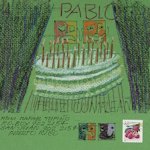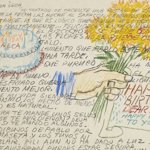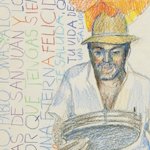
In the arts of Puerto Rico, Rafael Tufiño has defined the essence of what we are through an artistic language that is fundamentally the search for himself, but that also reveals the profiles of the collective to which he belongs. Tufiño transforms his imagery into a reflection of what we are, or what we think we are. The ability to perceive what is visible and immediately transform it into sign, emblem, or metaphor is a constant in his work.
This transformative possibility appears not just in his painting but also, and equally, in the graphic work, the posters, the drawings, and illustrations that he produced. Art as an instrument of affirmation of a way of being and feeling, but within the context of a desire to portray the features of a nationality under duress, was a thread that linked all the artists whom we have come to call the “Fifties Generation”.
The Museo de Las Américas is celebrating the centennial of Rafael Tufiño’s birth with an exhibition of the letters that Tufiño sent to his son Pablo. Tufiño, the “Oller of the twentieth century,” as I called him in the essay published in the catalog of his exhibition at the Museo de Arte de Puerto Rico titled No es lo mismo ser que estar, practiced the epistolary art with all of his children. An early example can be seen in the letter-newspaper El Moriviví that he sent to Nitza, his eldest daughter, in 1962 on the occasion of her thirteenth birthday.
The illustration is filled with humor, with a sleeping Tufiño dreaming that he is a bullfighter. At the bottom of the page he writes, “Nitza, I’ve put on my dreaming glasses to sleep in”.
The letters and postcards chosen for this exhibition number about thirty. Over some twenty years, Tufiño sent them to his youngest son, Pablo. The artist was 56 years old when his youngest child was born, so it’s only to be expected that these letters show the face of a loving, understanding, grandfatherly father. And as Pablo grew up, the things the letters talked about changed and evolved. In a kind of conversation, Tufiño tells Pablo about his daily activities, the friends he encounters in his walks through Old San Juan, and, later, his nighttime visits to the old city’s bars. But what is always there, in all the letters, are the expressions of love, understanding, and admiration Tufiño felt for Pablo and his intellectual and human development.
Dr. Teresa Tió Fernández
Curator








